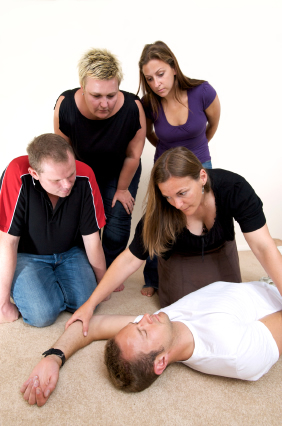A video that will introduce you to the article you are about to read. Neck Vessels and Heart-03 Inspection, Palpation and Percussion
[media url=”http://www.youtube.com/watch?v=ngelVIXuhTU” width=”600″ height=”400″]Injuries or conditions that impair, or that have the potential to impair, vital function of the CNS and cardiorespiratory system are considered to be emergency situations. In responding to an on-field or on-site injury, the initial assessment performed by the athletic trainer or any individual who has completed first aid courses is intended to rule out any life-threatening conditions. You have to learn the CPR changes for you to be updated.

In an on-site evaluation, the initial observation is completed en route to the injured individual and, therefore, occurs prior to the history taking. Critical areas to observe include firstly the surrounding environment. Any equipment or apparatus that may have contributed to the injury should be noted. Second is the body position. The position of the individual (e.g., prone, supine, or side-lying) should be observed. The appearance of a gross deformity in one of the limbs should be noted. In severe brain injuries, a neurologic sign called “posturing” of the extremities can occur. Decerebrate rigidity is characterized by extension of all four extremities. Decorticate rigidity is characterized by extension of the legs and marked flexion in the elbows, wrists, and fingers. Third is the movement of the individual. An individual holding an injured body part and expressing pain indicates consciousness as well as an intact CNS and cardiovascular system. If the individual is not moving or is having a seizure, possible systemic, psychological, or neurologic dysfunction should be suspected. Fourth is the level of responsiveness. Sometimes referred to the “shake and shout” stage, the examiner tries to arouse the unconscious individual by gently shaking (without moving the head or neck) and by shouting into each ear. This action will determine whether the person is alert, restless, lethargic, or nonresponsive. Fifth is the primary survey. The “ABC technique” should be employed to ensure an open Airway, adequate Breathing, and Circulation. Sixth is the inspection for head trauma. The pupils of the eyes should be observed, noting a normal appearance, dilation, or constriction. The facial area and the area behind the ears should be inspected for any redness or ecchymosis. The presence of any clear fluid or bloody discharge from the ears or nose should be noted; this fluid could be cerebrospinal fluid leaking from the cranial area as a result of a skull fracture. And lastly, inspection of the injured body part. The injured area should be checked for joint alignment, redness, ecchymosis, swelling, or cuts. These observations should always be compared to the uninjured body part. You have to take note that there are CPR levels for you to know.
For the on-site palpation, the palpation should include a general head-to-toe assessment. This is done using a gentle, squeezing motion to palpate methodically down the trunk of the body to the fingers and toes. Palpation includes: bony palpation; possible fractures (detected with palpation, percussion, vibration, compression, and distraction); crepitus (associated with fracture, swelling, or inflammation); soft-tissue palpation; swelling (may indicate diffuse hemorrhage or inflammation in a muscle, ligament, bursa, or joint capsule); deformity; and skin temperature (it is assessed by placing the back of the hand against the individual’s forehead or by palpating appendages bilaterally).
References:
Guertler AT. The clinical practice of emergency medicine. Emerg Med Clin North Am 1997;15(2):303–313.
http://downloads.lww.com/wolterskluwer_vitalstream_com/sample-content/9780781784450_Anderson/samples/98853.Ch5.pdf
